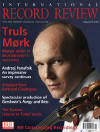Texte paru dans: / Appeared in:
*

International Record Review - (05//2014)
Pour
s'abonner / Subscription information
Christophorus
CHR77381

Code-barres / Barcode
: 4010072773814
Consultez toutes les évaluations recensées pour ce cd
~~~~ Reach all the evaluations located for this CD
Graupner reportedly wanted his works burned after his death. Since the employer who had paid for them wanted nothing of the sort, they instead lay on the shelves of a library in Darmstadt, a city better known nowadays for a different kind of music entirely. Nowadays the online sheet music library IMSLP hosts excellent scans of what seem to be his complete manuscripts, a bold step by the Universitäts‑ und Landesbibliothek Darmstadt in making this dauntingly enormous body of work (1,400‑plus cantatas!) widely accessible. Although musicians such as Hermann Max and Klaus Mertens have dipped their toes in the waters and a smattering of cantatas has appeared among Geneviève Soly's Graupner recordings there is still an immense amount of work still to be done and this new release from the Austrian soprano Miriam Feuersinger, containing three recorded premieres, constitutes a major contribution to what is still an unfairly tiny discography. It can hardly have been difficult deciding which of these cantatas would come first on the disc. Angst und Jammer, Qual und Trübsal is a major discovery, venturing far into musical territory where Graupner rarely trod: he generally preferred a gentle diatonic simplicity to this sort of tortured chromaticism. Its opening is quite stupendous, above all from Feuersinger: her opening note is sustained with such purity that it scarcely seems to be coming from a voice at all. This is Baroque languishing of the highest and most seductive order and certainly one of the finest Graupner moments on disc. The central do capo aria 'Mein Elend drückt mich fast zu Boden' again allows Feuersinger to suspend long lines against an expressively dissonant string fabric. She reorders some of the passagework in the closing aria (singing F sharp, A, G, F sharp, rather than Graupner's F sharp, G, A, F sharp in the demisemiquaver runs) ‑ no great matter although it does disturb the parallel writing with the solo violin. Furcht und Zagen begins in a similarly anguished minor‑key mood, continuing with an aria in more optimistic chorale prelude style; its final aria features imitative textures ,and a triple‑time central section.
The disc's first half sets the bar very high and it is a pity that some of the other recordings here do not quite reach the same level. Ich bleibe Gott getreu seems compositionally not as strong as its companions, the skipping 12/8 of its opening aria a little harmonically earthbound although the second aria ('Tobt, ihr Feinde, immerfort') achieves a surprisingly modern catchiness. Some breathiness creeps into Feuersinger's tone in the later cantatas on the disc, sometimes clearly intentional and effective (as at the beginning of Furcht und Zagen), sometimes seemingly less so on both counts ‑ the long slow lines in Ich bleibe Gott getreu sound as though they might have been a bit of a stretch. The cellist's strategy, particularly in the later works on the disc, of ornamenting the bass line and adding chords in viola da gamba style is not always convincing but defensible. His departing from the bass to add an additional harmony line is less so, depriving the harpsichord's bass of the sustaining support which it is surely the cello's function here to provide. (Certainly the cello part of the original materials ‑ a simple bass line, without figures ‑ provides no suggestion that the player might have done anything of the sort.)
Ach Gott und Herr is something of a hit by Graupner's standards, with at least three
recordings in relatively recent times (two of them from Montreal): Ingrid Schmithüsen
sang it with Soly's Ensemble des Idées Heureuses in their Analekta disc, while Emma Kirkby recorded it for BIS in 2006 with Theatre of Early Music. The Analekta recording remains the prime recommendation despite the expedient replacement of the
oboe obbligato with a recorder. Schmithüsen's delivery catches just the right simplicity of
tone, while
the tempos have a naturalness that eludes Schmithüsen and Soly's successors,
above all in the central 'Seufzt und weint' sequence. By contrast, the new
recording is even slower than the tempos proposed by the 1926 Noack edition.
The chorale melody of the opening movement barely hangs together, while 'Seufzt
und weint' stretches out to over 11 minutes compared to Schmithüsen's and
Soly's 7'49" ‑ certainly providing some beautiful moments but at the price
of breaking the musical span. Still, even if not everything here lives up to
the disc's stunning opening moments, there is certainly enough here to make
this well worth investigating. Hear the opening of Angst undjammer at
the very least: if that leaves you cold, Graupner might not be for you.
Fermer la fenêtre/Close window
Cliquez l'un ou l'autre
bouton pour découvrir bien d'autres critiques de CD
Click either button for many other reviews


